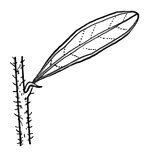Common name: Narrow-leaf Pomaderris
Pomaderris phylicifolia Lodd. ex Link APNI* 
Description: Shrub 1–2 m high, new growth with short branched hairs overtopped by long spreading hairs.
Leaves narrow-oblong to linear or oblanceolate, mostly 0.5–2 cm long, 1–3 mm wide, margins recurved to revolute; upper surface bristly with scattered simple hairs or rarely glabrous; lower surface tomentose with stellate hairs with longer simple hairs on midrib, secondary veins sometimes visible.
Flowers pale yellow, in short axillary cymes forming narrow terminal panicles. Sepals not persistent in fruit. Petals absent.
Capsule and ovary hairy, capsule immersed for about a third of its length in the tomentose hypanthium.
Distribution and occurrence: Widespread, but not common; chiefly on the coast and ranges south from the Blue Mtns, also at Cathedral Rock N.P.
NSW subdivisions: CC, SC, NT, CT, ST, CWS
Other Australian states: Vic. Tas.
Text by G.J. Harden
Taxon concept:
| | Key to the subspecies | |
| 1 | Leaves >1.5 mm wide, ± flat with margins recurved, lower surface of lamina visible, secondary veins sometimes visible. | subsp. phylicifolia |
| Leaves <1.5 mm wide, ± terete, margins strongly revolute, lower surface of lamina scarcely visible, secondary veins not visible. | subsp. ericoides |
APNI* Provides a link to the Australian Plant Name Index (hosted by the Australian National Botanic Gardens) for comprehensive bibliographic data
***The AVH map option provides a detailed interactive Australia wide distribution map drawn from collections held by all major Australian herbaria participating in the Australian Virtual Herbarium project.
|


